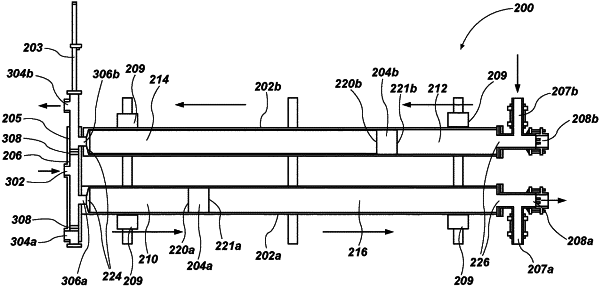| CPC F15B 3/00 (2013.01) [F15B 11/02 (2013.01); F15B 11/046 (2013.01); F15B 15/2861 (2013.01)] | 19 Claims |

|
1. A device for exchanging pressure between fluids, the device comprising:
at least two tanks, each tank of the at least two tanks comprising:
a first side for receiving a first fluid at a higher pressure; and
a second side for receiving a second fluid at a lower pressure;
a piston independently disposed in each tank of the at least two tanks, the piston configured to travel unconstrained within the respective tank from a first axial end to a second axial end of the tank, the piston configured to separate the first fluid from the second fluid;
a control valve coupled to each of the at least two tanks at the first axial end of the respective tank, the control valve configured to selectively place the first fluid at the higher pressure in communication with the second fluid at the lower pressure through the piston in order to pressurize the second fluid to a second higher pressure in each of the at least two tanks;
at least two sensors coupled to each tank of the at least two tanks, the at least two sensors on each of the at least two tanks configured to detect a presence of the piston, a first sensor of the at least two sensors being positioned proximate the first axial end of the tank and a second sensor of the at least two sensors being positioned proximate the second axial end of the tank, the first sensor being axially spaced from the first axial end of the tank to define a first volume in which the piston is configured to travel at the first axial end of the tank between the first sensor and the first axial end, the second sensor being axially spaced from the second axial end of the tank to define a second volume in which the piston is configured to travel at the second axial end of the tank between the second sensor and the second axial end; and
a controller configured to receive a signal from the at least two sensors on each of the at least two tanks, the controller configured to enable the piston to contact the second axial end while preventing the piston from contacting the first axial end.
|